Louis Armstrong (1901-1971) was The King of the Jazz Trumpet. Armstrong, nicknamed 'Satchmo', is renowned for his charismatic stage presence and voice almost as much as for his trumpet playing. He recorded hit songs for five decades and composed dozens of songs that have become jazz standards. Armstrong was one of the most important creative forces in the early development and perpetuation of Jazz. With his superb comic timing and unabashed joy of life, Louis Armstrong also appeared in more than thirty films.

French postcard. Photo: Philippe Halsman / Magnum. Caption: The American jazzman Louis Armstrong, photographed in 1966.

German postcard by Edition Tushita, Duisburg / Innenhafen, no. B 507. Photo: Tushita / Owa.

British postcard by Monochrome, London, 1988. Photo: William Gottlieb / DRP. Caption: Louis 'Satchmo' Armstrong.

American postcard by Fotofolio, NY, NY, no. M90. Photo: Photographer unidentified / Collection Ole Brask. Louis Armstrong and Billie Holiday on a publicity still for New Orleans (Arthur Lubin, 1947), the only time Billie Holiday performed in a feature film.

American postcard by Fotofolio, NY, NY, no. M100. Photo: Phil Stern. Louis Armstrong and Billie Holiday in New Orleans (Arthur Lubin, 1947). Caption: Louis Armstrong and Billie Holiday, Hollywood, 1949. (Sic, it must be 1947).
Louis Daniel Armstrong was born in New Orleans, Louisiana, in the Storyville District known as 'the Battlefield' in 1901. His parents were Mary Albert and William Armstrong. William abandoned the family shortly after, and Louis grew up poor in a single-parent household. He left school in the 5th grade to help support his family. He sang on street corners, sold newspapers and delivered coal. Louis was 13 when he celebrated New Year's Eve in 1912 by running out on the street and firing a blank from a pistol that belonged to the current man in his mother's life. He was arrested and placed in the Colored Waif's Home for boys. There, he learned to play the bugle, cornet and the clarinet and joined the home's brass band. Armstrong's first teacher, Peter Davis, taught him there to read music. After 18 months, Louis left the Home determined to become a musician.
The young Armstrong played in brass bands and riverboats in New Orleans, first on an excursion boat in September 1918. At 18, he got a job in the Kid Ory Band in New Orleans. Armstrong married Daisy Parker as his career as a musician developed. In 1922, he followed his mentor, Joe 'King' Oliver, to Chicago to play in the Creole Jazz Band. He made his first recordings with that band in 1923. While in Chicago, Armstrong networked with other jazz musicians, reconnecting with his friend, Bix Beiderbecke, and made new contacts, which included Hoagy Carmichael and Lil Hardin.
Lil was a graduate of Fisk University and an excellent pianist who could read, write and arrange music. She encouraged and enhanced Louis's career, and they married in 1924. Armstrong became very popular and one of the genre's most sought-after trumpeters. He travelled a great deal and spent considerable time in Chicago and New York. He first moved to the Big Apple in 1924 to join Fletcher Henderson's Orchestra. He stayed in New York for a while but moved back to Chicago in October of 1925.
Armstrong later went back to New York in 1929. He appeared on Broadway in 'Hot Chocolates', in which he introduced Fats Waller's 'Ain't Misbehavin'', his first popular song hit. During that time, some of his most important and successful work was accomplished with his Hot Fives and Hot Sevens Bands. Armstrong's interpretation of Hoagy Carmichael's 'Stardust' became one of the most successful versions of this song ever recorded, showcasing Armstrong's unique vocal sound and style and his innovative approach to singing songs that had already become standards. In 1931, Armstrong appeared in his first film, Ex-Flame. That year, Armstrong and Lil Hardin separated and later divorced in 1938.
Dale O'Connor at IMDb: "He made a tour of Europe in 1932. During a command performance for King George V, he forgot he had been told that performers were not to refer to members of the royal family while playing for them. Just before picking up his trumpet for a really hot number, he announced: 'This one's for you, Rex.'" After this Grand Tour of Europe, 'Satchmo' became Armstrong's nickname. A London music magazine editor had written erroneously 'Satchmo' in an article (Armstrong's nickname was 'Satchelmouth'), and the name stuck. In 1937, Armstrong substituted for Rudy Vallee on the CBS radio network and became the first African American to host a sponsored, national broadcast. After his divorce, Louis married Alpha Smith in 1938. While maintaining a vigorous work schedule, as well as living and travelling back and forth to Chicago and California, Armstrong moved back to New York in the late 1930s and later married Lucille Wilson in 1942.
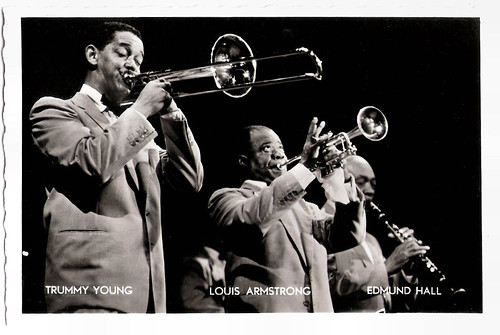
Dutch postcard by N.V. Int. Filmpers (I.F.P.), Amsterdam, no. 1035. Photo: Joel Elkins. Louis Armstrong in the 1955 version of the All Stars, with Trummy Young on trombone and vocals, and Edmond Hall on clarinet and vocals.
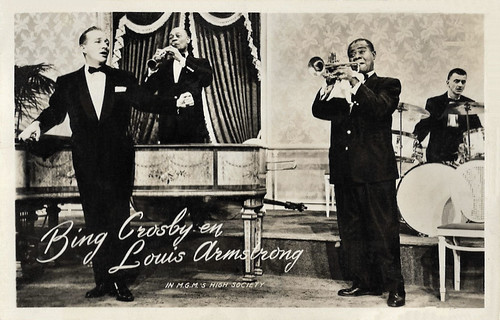
Dutch postcard by Uitg. Takken, Utrecht, no. 3024. Photo: MGM. Publicity still for High Society (Charles Walters, 1956) with Bing Crosby.

Dutch postcard by Uitg. Takken, Utrecht, no. 3014. Photo: MGM. Bing Crosby and Louis Armstrong in High Society (Charles Walters, 1956).
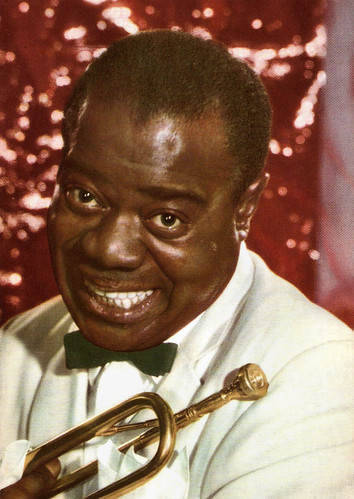
French postcard by Editions P.I., Paris, no. CK-289. Photo: Arthur Grimm / Ufa.
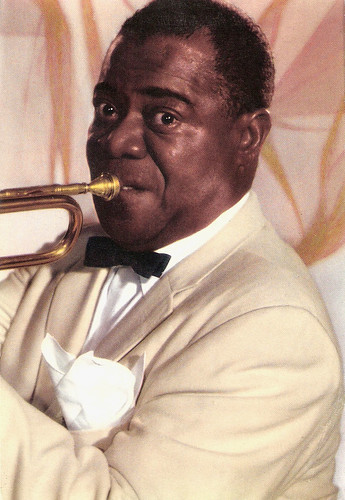
German postcard by ISV, no. H 37.
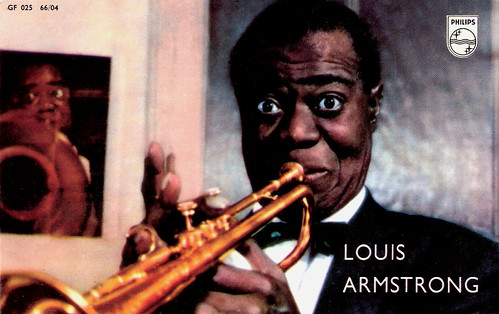
Dutch promotion card by Philips, no. GF 025 66/04.
Louis Armstrong was also an influential singer, with his instantly recognisable gravelly voice. He demonstrated great mastery as an improviser, bending the lyrics and melody of a song for expressive purposes. He was also very skilled at scat singing. Although his career as a recording artist dates back to the 1920s, when he made now-classic recordings with Joe 'King' Oliver, Bessie Smith and Jimmie Rodgers, as well as his own Hot Five and Hot Seven groups, his biggest hits as a recording artist came comparatively late in his life. Armstrong had nineteen Top Ten hits, including 'When The Saints Go Marching In' (1938), 'Mack the Knife' (1955), 'Stompin' at the Savoy' (1956) with Ella Fitzgerald, and 'What a Wonderful World' (1967).
Armstrong's influence extended well beyond jazz, and by the end of his career in the 1960s, he was widely regarded as a profound influence on popular music in general. In 1964, Armstrong knocked The Beatles off the top of the Billboard Hot 100 chart with 'Hello, Dolly!', which gave the 63-year-old performer a U.S. record as the oldest artist to have a number one song. Armstrong appeared in more than a dozen Hollywood films, usually playing a bandleader or musician. He appeared with Bing Crosby in the musical Pennies from Heaven (Norman Z. MacLeod, 1936) and with Mae West in Every Day's a Holiday (A. Edward Sutherland, 1937).
In the innovative musical Cabin in the Sky (Vincente Minnelli, Busby Berkeley, 1943) featuring an all-star, all-black cast, Louis played 'The Trumpeter' opposite Ethel Waters and Lena Horne. In 1947, he played himself opposite Billie Holiday in New Orleans (Arthur Lubin, 1947), which chronicled the demise of the Storyville district and the ensuing exodus of musicians from New Orleans to Chicago. Armstrong also joined Danny Kaye and Virginia Mayo in the comedy A Song Is Born (Howard Hawks, 1948). The best parts of the film are the music scenes with Armstrong, Tommy Dorsey, Charlie Barnett, Lionel Hampton, and Benny Goodman, playing kick-arse Jazz. In The Glenn Miller Story (Anthony Mann, 1954), Armstrong jammed with Miller (James Stewart) and a few other noted musicians of the time.
His most familiar role was as the bandleader in the musical High Society (Charles Walters, 1956). He functions as a very partisan Greek Chorus, who tells you right up front who he's pulling for to win Grace Kelly, and he helps musically along the way, performing a duet with Bing Crosby. In The Five Pennies (Melville Shavelson, 1959), the story of the cornetist Red Nichols, Armstrong played himself as well as singing and playing several classic numbers. With leading actor Danny Kaye, Armstrong performed a duet of 'When the Saints Go Marching In', during which Kaye impersonated Armstrong. He also appeared in several European films, including the Italian-French musical Saluti e baci / The Road to Happiness (Maurice Labro, Giorgio Simonelli, 1953) with Georges Guétary, the German musical Die Nacht vor der Premiere / The Night before the Premiere (Georg Jacoby, 1959) with Marika Rökk, and the Danish musical Kærlighedens melodi / The melody of love (Bent Christensen, 1959) with Nina and Frederik.
Louis Armstrong was one of the first truly popular African-American entertainers to 'cross over', whose skin colour was secondary to his music in an America that was extremely racially divided at the time. He rarely publicly politicised his race, often to the dismay of fellow African Americans, but Armstrong was the only Black Jazz musician to publicly speak out against school segregation in 1957 during the Little Rock crisis. His artistry and personality allowed him access to the upper echelons of American society, then highly restricted for black men. Despite his fame, he remained a humble man and lived a simple life in a working-class neighbourhood Armstrong remained married to Lucille Wilson until he died in 1971, a month away from what would have been his 70th birthday on 4 August. Embittered by the treatment of blacks in his hometown of New Orleans, he chose to be buried in New York City at the Flushing Cemetery, not too far from his home in Corona, Queens. He left his entire estate to his beloved wife, who died in 1983. Armstrong wrote two autobiographies. His house in Corona, where Armstrong lived for almost 28 years, was declared a National Historic Landmark in 1977. Today, it is a museum where fans can check out his residence and its belongings as a citizen of New York City.

French postcard by Humour a la Carte, Paris, no. ST 258. Photo: Culver Pictures.

Belgian postcard in the Hot Club series by Edition John Prevot, Anvers (Antwerp), no. 19.
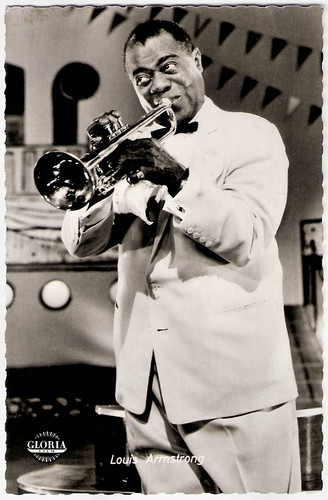
German postcard by Kolibri-Verlag, Minden/Westf., no. 765. no. CK-289. Photo: Alfa / Gloria / Kiebig. Publicity still for La Paloma (Paul Martin, 1959).
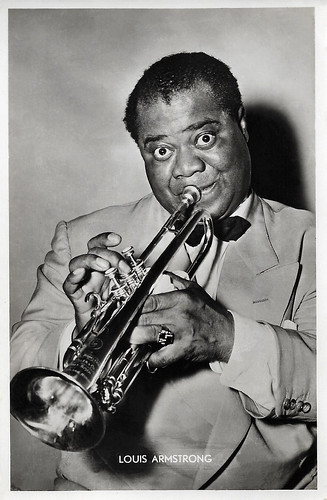
Vintage postcard, no. 111.
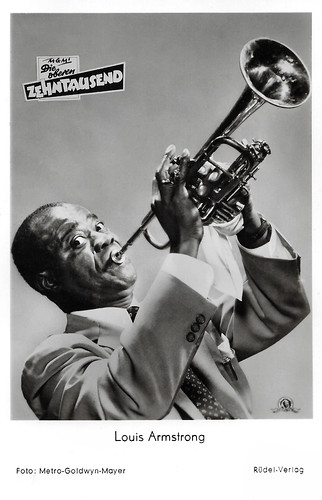
German postcard by Rüdel-Verlag, Hamburg-Bergedorf, no. 1988. Photo: MGM. Publicity still for High Society (Charles Walters, 1956). The German title of the film is Die oberen Zehntausend (The top ten thousand).

Dutch postcard by Gebr. Spanjersberg N.V., Rotterdam. Danny Kaye and Louis Armstrong in The Five Pennies (Melville Shavelson, 1959).

German postcard by Edition Tushita, no. B 515. Photo: AKG, Berlin / Tushita. Louis Armstrong in The Beat Generation (Charles F. Haas, 1959).

French postcard by Editions du Désastre, Paris, no. N105. Photo: Jack Nisberg. Paul Newman and Louis Armstrong in Paris Blues (Martin Ritt, 1961).

Dutch promotion card by Artone / Verve Records, Haarlem. Ella Fitzgerald and Louis Armstrong.

French postcard in the Entr'acte series by Éditions Asphodèle, Mâcon, no. 005/13. Collection: B. Courtel / D.R. Louis Armstrong, Barbra Streisand, and Gene Kelly on the set of Hello Dolly! (Gene Kelly, 1969). Caption: A moment of pause for Gene Kelly and his stars, Barbra Streisand and Louis Armstrong.
Sources: Dale O'Connor (IMDb), Louis Armstrong Educational Foundation, Wikipedia and IMDb.

French postcard. Photo: Philippe Halsman / Magnum. Caption: The American jazzman Louis Armstrong, photographed in 1966.

German postcard by Edition Tushita, Duisburg / Innenhafen, no. B 507. Photo: Tushita / Owa.

British postcard by Monochrome, London, 1988. Photo: William Gottlieb / DRP. Caption: Louis 'Satchmo' Armstrong.

American postcard by Fotofolio, NY, NY, no. M90. Photo: Photographer unidentified / Collection Ole Brask. Louis Armstrong and Billie Holiday on a publicity still for New Orleans (Arthur Lubin, 1947), the only time Billie Holiday performed in a feature film.

American postcard by Fotofolio, NY, NY, no. M100. Photo: Phil Stern. Louis Armstrong and Billie Holiday in New Orleans (Arthur Lubin, 1947). Caption: Louis Armstrong and Billie Holiday, Hollywood, 1949. (Sic, it must be 1947).
Born in the Battlefield
Louis Daniel Armstrong was born in New Orleans, Louisiana, in the Storyville District known as 'the Battlefield' in 1901. His parents were Mary Albert and William Armstrong. William abandoned the family shortly after, and Louis grew up poor in a single-parent household. He left school in the 5th grade to help support his family. He sang on street corners, sold newspapers and delivered coal. Louis was 13 when he celebrated New Year's Eve in 1912 by running out on the street and firing a blank from a pistol that belonged to the current man in his mother's life. He was arrested and placed in the Colored Waif's Home for boys. There, he learned to play the bugle, cornet and the clarinet and joined the home's brass band. Armstrong's first teacher, Peter Davis, taught him there to read music. After 18 months, Louis left the Home determined to become a musician.
The young Armstrong played in brass bands and riverboats in New Orleans, first on an excursion boat in September 1918. At 18, he got a job in the Kid Ory Band in New Orleans. Armstrong married Daisy Parker as his career as a musician developed. In 1922, he followed his mentor, Joe 'King' Oliver, to Chicago to play in the Creole Jazz Band. He made his first recordings with that band in 1923. While in Chicago, Armstrong networked with other jazz musicians, reconnecting with his friend, Bix Beiderbecke, and made new contacts, which included Hoagy Carmichael and Lil Hardin.
Lil was a graduate of Fisk University and an excellent pianist who could read, write and arrange music. She encouraged and enhanced Louis's career, and they married in 1924. Armstrong became very popular and one of the genre's most sought-after trumpeters. He travelled a great deal and spent considerable time in Chicago and New York. He first moved to the Big Apple in 1924 to join Fletcher Henderson's Orchestra. He stayed in New York for a while but moved back to Chicago in October of 1925.
Armstrong later went back to New York in 1929. He appeared on Broadway in 'Hot Chocolates', in which he introduced Fats Waller's 'Ain't Misbehavin'', his first popular song hit. During that time, some of his most important and successful work was accomplished with his Hot Fives and Hot Sevens Bands. Armstrong's interpretation of Hoagy Carmichael's 'Stardust' became one of the most successful versions of this song ever recorded, showcasing Armstrong's unique vocal sound and style and his innovative approach to singing songs that had already become standards. In 1931, Armstrong appeared in his first film, Ex-Flame. That year, Armstrong and Lil Hardin separated and later divorced in 1938.
Dale O'Connor at IMDb: "He made a tour of Europe in 1932. During a command performance for King George V, he forgot he had been told that performers were not to refer to members of the royal family while playing for them. Just before picking up his trumpet for a really hot number, he announced: 'This one's for you, Rex.'" After this Grand Tour of Europe, 'Satchmo' became Armstrong's nickname. A London music magazine editor had written erroneously 'Satchmo' in an article (Armstrong's nickname was 'Satchelmouth'), and the name stuck. In 1937, Armstrong substituted for Rudy Vallee on the CBS radio network and became the first African American to host a sponsored, national broadcast. After his divorce, Louis married Alpha Smith in 1938. While maintaining a vigorous work schedule, as well as living and travelling back and forth to Chicago and California, Armstrong moved back to New York in the late 1930s and later married Lucille Wilson in 1942.

Dutch postcard by N.V. Int. Filmpers (I.F.P.), Amsterdam, no. 1035. Photo: Joel Elkins. Louis Armstrong in the 1955 version of the All Stars, with Trummy Young on trombone and vocals, and Edmond Hall on clarinet and vocals.

Dutch postcard by Uitg. Takken, Utrecht, no. 3024. Photo: MGM. Publicity still for High Society (Charles Walters, 1956) with Bing Crosby.

Dutch postcard by Uitg. Takken, Utrecht, no. 3014. Photo: MGM. Bing Crosby and Louis Armstrong in High Society (Charles Walters, 1956).

French postcard by Editions P.I., Paris, no. CK-289. Photo: Arthur Grimm / Ufa.

German postcard by ISV, no. H 37.

Dutch promotion card by Philips, no. GF 025 66/04.
One of the first truly popular African-American entertainers to 'cross over'
Louis Armstrong was also an influential singer, with his instantly recognisable gravelly voice. He demonstrated great mastery as an improviser, bending the lyrics and melody of a song for expressive purposes. He was also very skilled at scat singing. Although his career as a recording artist dates back to the 1920s, when he made now-classic recordings with Joe 'King' Oliver, Bessie Smith and Jimmie Rodgers, as well as his own Hot Five and Hot Seven groups, his biggest hits as a recording artist came comparatively late in his life. Armstrong had nineteen Top Ten hits, including 'When The Saints Go Marching In' (1938), 'Mack the Knife' (1955), 'Stompin' at the Savoy' (1956) with Ella Fitzgerald, and 'What a Wonderful World' (1967).
Armstrong's influence extended well beyond jazz, and by the end of his career in the 1960s, he was widely regarded as a profound influence on popular music in general. In 1964, Armstrong knocked The Beatles off the top of the Billboard Hot 100 chart with 'Hello, Dolly!', which gave the 63-year-old performer a U.S. record as the oldest artist to have a number one song. Armstrong appeared in more than a dozen Hollywood films, usually playing a bandleader or musician. He appeared with Bing Crosby in the musical Pennies from Heaven (Norman Z. MacLeod, 1936) and with Mae West in Every Day's a Holiday (A. Edward Sutherland, 1937).
In the innovative musical Cabin in the Sky (Vincente Minnelli, Busby Berkeley, 1943) featuring an all-star, all-black cast, Louis played 'The Trumpeter' opposite Ethel Waters and Lena Horne. In 1947, he played himself opposite Billie Holiday in New Orleans (Arthur Lubin, 1947), which chronicled the demise of the Storyville district and the ensuing exodus of musicians from New Orleans to Chicago. Armstrong also joined Danny Kaye and Virginia Mayo in the comedy A Song Is Born (Howard Hawks, 1948). The best parts of the film are the music scenes with Armstrong, Tommy Dorsey, Charlie Barnett, Lionel Hampton, and Benny Goodman, playing kick-arse Jazz. In The Glenn Miller Story (Anthony Mann, 1954), Armstrong jammed with Miller (James Stewart) and a few other noted musicians of the time.
His most familiar role was as the bandleader in the musical High Society (Charles Walters, 1956). He functions as a very partisan Greek Chorus, who tells you right up front who he's pulling for to win Grace Kelly, and he helps musically along the way, performing a duet with Bing Crosby. In The Five Pennies (Melville Shavelson, 1959), the story of the cornetist Red Nichols, Armstrong played himself as well as singing and playing several classic numbers. With leading actor Danny Kaye, Armstrong performed a duet of 'When the Saints Go Marching In', during which Kaye impersonated Armstrong. He also appeared in several European films, including the Italian-French musical Saluti e baci / The Road to Happiness (Maurice Labro, Giorgio Simonelli, 1953) with Georges Guétary, the German musical Die Nacht vor der Premiere / The Night before the Premiere (Georg Jacoby, 1959) with Marika Rökk, and the Danish musical Kærlighedens melodi / The melody of love (Bent Christensen, 1959) with Nina and Frederik.
Louis Armstrong was one of the first truly popular African-American entertainers to 'cross over', whose skin colour was secondary to his music in an America that was extremely racially divided at the time. He rarely publicly politicised his race, often to the dismay of fellow African Americans, but Armstrong was the only Black Jazz musician to publicly speak out against school segregation in 1957 during the Little Rock crisis. His artistry and personality allowed him access to the upper echelons of American society, then highly restricted for black men. Despite his fame, he remained a humble man and lived a simple life in a working-class neighbourhood Armstrong remained married to Lucille Wilson until he died in 1971, a month away from what would have been his 70th birthday on 4 August. Embittered by the treatment of blacks in his hometown of New Orleans, he chose to be buried in New York City at the Flushing Cemetery, not too far from his home in Corona, Queens. He left his entire estate to his beloved wife, who died in 1983. Armstrong wrote two autobiographies. His house in Corona, where Armstrong lived for almost 28 years, was declared a National Historic Landmark in 1977. Today, it is a museum where fans can check out his residence and its belongings as a citizen of New York City.

French postcard by Humour a la Carte, Paris, no. ST 258. Photo: Culver Pictures.

Belgian postcard in the Hot Club series by Edition John Prevot, Anvers (Antwerp), no. 19.

German postcard by Kolibri-Verlag, Minden/Westf., no. 765. no. CK-289. Photo: Alfa / Gloria / Kiebig. Publicity still for La Paloma (Paul Martin, 1959).

Vintage postcard, no. 111.

German postcard by Rüdel-Verlag, Hamburg-Bergedorf, no. 1988. Photo: MGM. Publicity still for High Society (Charles Walters, 1956). The German title of the film is Die oberen Zehntausend (The top ten thousand).

Dutch postcard by Gebr. Spanjersberg N.V., Rotterdam. Danny Kaye and Louis Armstrong in The Five Pennies (Melville Shavelson, 1959).

German postcard by Edition Tushita, no. B 515. Photo: AKG, Berlin / Tushita. Louis Armstrong in The Beat Generation (Charles F. Haas, 1959).

French postcard by Editions du Désastre, Paris, no. N105. Photo: Jack Nisberg. Paul Newman and Louis Armstrong in Paris Blues (Martin Ritt, 1961).

Dutch promotion card by Artone / Verve Records, Haarlem. Ella Fitzgerald and Louis Armstrong.

French postcard in the Entr'acte series by Éditions Asphodèle, Mâcon, no. 005/13. Collection: B. Courtel / D.R. Louis Armstrong, Barbra Streisand, and Gene Kelly on the set of Hello Dolly! (Gene Kelly, 1969). Caption: A moment of pause for Gene Kelly and his stars, Barbra Streisand and Louis Armstrong.
Sources: Dale O'Connor (IMDb), Louis Armstrong Educational Foundation, Wikipedia and IMDb.
No comments:
Post a Comment